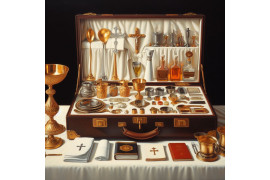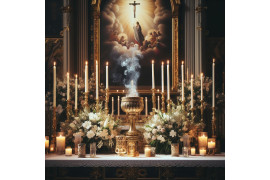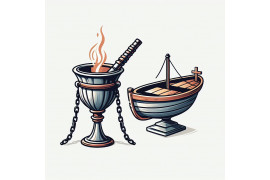Catholics have a deep appreciation for candlesticks in their worship practices. These sacred objects hold significant symbolism and play an integral role in Catholic liturgical ceremonies. Candles are used to represent the presence of Christ, with their flames symbolizing the light of Christ illuminating darkness. The use of candles dates back to early Christian practices and continues to be an essential part of Catholic worship today.
During sacraments such as baptism or the Easter Vigil, votive candles are often lit to signify moments of spiritual significance. Advent candles and wreaths are also commonly used during the Advent season, symbolizing the anticipation and preparation for the birth of Jesus Christ. Furthermore, candlesticks serve as a visual reminder of the martyrs who sacrificed their lives for their faith.
In this blog post, we will delve deeper into why Catholics have a fondness for candlesticks, exploring their historical significance and the rich symbolism they hold within Catholic worship practices.
Importance of Candles in Rituals and Traditions
Catholics have a deep appreciation for candles and consider them an essential part of their religious practices. Lighting candles holds great significance in Catholic rituals, serving as a way to express devotion and reverence. Let's explore why Catholics hold candlesticks in such high regard.
Lighting candles is a way for Catholics to express devotion and reverence.
When Catholics light candles, it is not just a mundane task; it is a sacred act that symbolizes their connection with God. The flickering flame represents the presence of the divine and serves as a visual reminder of their faith. By lighting candles, Catholics demonstrate their devotion to God and seek His blessings.
Candles create a sacred atmosphere during religious rituals.
In Catholic churches, the soft glow of lit candles creates an ambiance conducive to prayer and worship. The gentle illumination helps to focus attention on the sacred space and encourages introspection. Whether it's during Mass or personal prayer time, the presence of candlelight enhances the spiritual experience for believers.
Different colors of candles hold specific meanings in Catholic traditions.
Catholic traditions assign different meanings to various colors of candles used in religious ceremonies. Each color carries its own symbolism:
-
White: Represents purity, innocence, and holiness.
-
Red: Symbolizes sacrifice, martyrdom, and the Holy Spirit.
-
Purple: Signifies penance, preparation, and anticipation.
-
Green: Represents hope, growth, and renewal.
-
Blue: Symbolizes Mary, the mother of Jesus.
-
Pink: Signifies joy and celebration (often used during Advent).
These distinct colors add depth and meaning to Catholic rituals by conveying specific emotions or themes associated with each liturgical season or occasion.
The act of lighting a candle can serve as a personal prayer or intention.
Beyond its use in formal church settings, lighting a candle holds personal significance for many Catholics. It provides an opportunity for individuals to offer their prayers, intentions, and petitions to God. The act of lighting a candle can be seen as a tangible representation of their desires and a means to seek divine intervention or guidance in their lives.
Historical Significance of Candle Lighting
Ancient Origins of Candle Lighting
Candle lighting has a long history that dates back to ancient times. The practice of lighting candles during religious rituals can be traced back to various cultures and traditions. Early Christians, for instance, adopted the custom from both Jewish and pagan customs.
Adoption by Early Christians
In the early days of Christianity, candle lighting held deep symbolic meaning. Candles were seen as a representation of divine illumination and were used to signify the presence of God. The soft glow emitted by candlelight was believed to create a sacred atmosphere, enhancing spiritual connections during worship.
Medieval Symbolism
During the medieval period, candles took on even greater significance within the Catholic Church. They became an integral part of religious ceremonies and were often associated with important events such as baptisms, weddings, and funerals. In this context, candles represented purity, enlightenment, and guidance along one's spiritual journey.
Renaissance Era: Increased Availability and Affordability
The Renaissance era brought about significant changes in many aspects of life, including the availability and affordability of candles. With advancements in technology and trade routes expanding across continents, candles became more accessible to people from all walks of life.
This accessibility led to an increased use of candles in Catholic churches and homes alike. The soft flickering light provided by candles created an ambiance conducive to prayer, meditation, and reflection.
Continued Significance Today
Even in modern times, candle lighting remains an integral part of Catholic tradition for several reasons:
-
Symbolic Representation: Candles continue to symbolize divine presence and illumination within the church setting.
-
Focus and Reverence: The act of lighting a candle helps individuals focus their attention on prayer or contemplation.
-
Ritualistic Tradition: Many Catholics find comfort in participating in age-old rituals that have been passed down through generations.
-
Visual Aid: Candlelight provides a visual reminder of the spiritual realm and serves as a tangible representation of faith.
Role of Candlesticks in Ceremonies and Masses
Candlesticks play a significant role in Catholic ceremonies and Masses. These sacred objects hold the candles that are used during various religious rituals, adding an element of reverence and symbolism to the proceedings.
Candlesticks Hold Candles Used During Mass and Other Ceremonies
One of the primary functions of candlesticks is to hold candles during Mass and other liturgical processions. The flickering flames of these candles create a serene and solemn atmosphere, enhancing the spiritual experience for worshipers. The use of candlelight has been an integral part of religious rituals for centuries, symbolizing the presence of God's light in our lives.
They Are Often Made from Precious Metals like Gold or Silver
Catholic candlesticks are often crafted from precious metals such as gold or silver. This choice of materials reflects their importance and sacred nature within the Church. The use of precious metals also symbolizes the value placed on worship and devotion to God. These materials have practical benefits as they do not tarnish easily, ensuring that the candlesticks maintain their beauty over time.
Candlesticks Have Intricate Designs that Reflect Their Sacred Purpose
Another notable aspect of Catholic candlesticks is their intricate designs. These designs often incorporate religious symbols, intricate carvings, or ornate patterns that reflect their sacred purpose. The craftsmanship involved in creating these candlesticks showcases the dedication and attention to detail given to objects used in worship.
Their Placement on the Altar Signifies Their Importance in Worship
The placement of candlesticks on the altar holds great significance during Catholic ceremonies and Masses. Typically positioned on either side of the altar, they serve as a visual representation of God's presence among His people. This placement emphasizes their importance in worship and serves as a focal point for congregants' prayers.
Candlesticks Play a Key Role in Funeral Processions
Candlesticks also play a crucial role in funeral processions within the Catholic tradition. During these solemn occasions, candlesticks are used to hold votive candles, which are lit to honor the deceased and symbolize their eternal light. The presence of candlelight brings comfort and solace to mourners as they bid farewell to their loved ones.
Spiritual Meaning Behind Catholic Candle Lighting
Lighting a candle holds significant spiritual meaning for Catholics. It goes beyond simply providing illumination; it is a symbolic act that represents offering prayers to God or saints. This practice is deeply rooted in the Catholic tradition and holds great importance in their religious rituals.
Offering Prayers and Seeking Guidance
When Catholics light a candle, they are expressing their desire to connect with the divine realm. The flickering flame symbolizes seeking guidance, protection, or intercession from heavenly beings. It is believed that the light from candles acts as a beacon, guiding their prayers to God or saints.
Connection with the Divine Realm
Catholics view the act of lighting candles as a way to establish a connection with the divine realm. The true light emitted by candles is seen as a representation of Christ, who described Himself as "the Light of the World." By lighting candles, Catholics believe they are inviting this divine light into their lives and creating an atmosphere conducive to spiritual reflection and contemplation.
Creating an Atmosphere of Reverence
The use of candlelight in religious settings helps create an atmosphere of reverence and solemnity. The soft glow emanating from candles adds a sense of warmth and serenity to church spaces, enhancing the overall spiritual experience for worshipers. The flickering flames serve as a visual reminder of God's presence and His eternal love for His people.
Symbolic Representation
Catholicism places great emphasis on symbolism, and candle lighting carries deep symbolic meaning within this faith tradition. Candles are often associated with purity and represent Christ's presence among believers. They also symbolize hope, as they dispel darkness, just as Jesus brings hope into people's lives.
Enhancing Prayerful Intentions
In addition to its symbolic significance, lighting candles during prayer enhances one's intentions and focus. The act itself helps individuals enter into a state of prayerful contemplation by engaging multiple senses. The gentle glow, the flickering flame, and the scent of candles all contribute to creating a sacred ambiance that aids in concentration and spiritual connection.
Connection Between Candles and Prayer in Catholic Faith
In the Catholic faith, lighting candles during prayer holds significant symbolism and meaning. It serves as a visual representation of one's intentions and devotion. The flickering flame of a candle can help to focus thoughts and create a sacred atmosphere for prayer.
Visual Representation of Intentions
Catholics often light candles while praying as a way to visually express their intentions. Each lit candle represents a specific prayer or intention offered up to God. It is believed that the flame carries these prayers upward, like smoke rising from the burning candle.
Symbolism of Prayers Rising to Heaven
The act of lighting a candle during prayer serves as a reminder that prayers ascend to heaven, reaching the ears of God. Just as the flame illuminates darkness, prayers bring light into our lives and connect us with the divine. This symbolism reinforces the belief that God hears and answers our prayers.
Focusing Thoughts During Prayer
The flickering flame of a lit candle can aid in concentration and meditation during prayer. As we gaze at the dancing flame, our minds become more centered on our conversation with God. The gentle movement captivates our attention, allowing us to let go of distractions and focus solely on our spiritual connection.
Designated Areas for Candle Lighting
Many churches have designated areas where individuals can light candles and offer their prayers. These spaces are often adorned with statues or images of saints, creating an ambiance conducive to reflection and reverence. Lighting a candle in these areas signifies an act of devotion, inviting individuals to enter into deep communion with their faith.
Personalized Acts of Devotion
Lighting candles during prayer is not limited to church settings alone; it is also practiced in homes or personal altars. Individuals may choose to set up a small area dedicated to prayer within their own living space. This allows for more intimate moments of devotion where personal intentions can be offered up through the act of candle lighting.
Fascination with Candlesticks in Catholicism
The fascination with candlesticks in Catholicism stems from the importance of candles in rituals and traditions. Candles hold symbolic significance within the Catholic faith, representing light, purity, and divine presence. Lighting candles during ceremonies and masses creates a sacred atmosphere and enhances the spiritual experience for worshipers.
Historically, candle lighting has played a significant role in religious practices across cultures. In Catholicism, this tradition dates back centuries and carries a deep-rooted symbolism. Candlesticks are used to hold the candles during religious services, symbolizing the light of Christ illuminating the path for believers. The act of lighting a candle also represents prayerful intentions and serves as a physical manifestation of one's devotion.
In conclusion, candlesticks hold great importance in Catholicism due to their connection to rituals, traditions, and spiritual symbolism. They contribute to creating an environment conducive to worship and prayer. Whether it be through historical significance or spiritual meaning, candlesticks play a vital role in enhancing the faith experience for Catholics.
FAQs
Can I use any type of candlestick for Catholic ceremonies?
While there isn't a specific requirement for the type of candlestick used in Catholic ceremonies, it is customary to use ornate and traditional designs that reflect the reverence of the occasion.
What materials are commonly used for making Catholic candlesticks?
Catholic candlesticks are often crafted from brass or other metals like silver or gold-plated materials. These materials provide durability while adding an aesthetic element to enhance the sacredness of the ritual.
Are there specific guidelines for lighting candles at home?
While there are no strict rules regarding lighting candles at home, it is recommended to create a designated space free from flammable objects and ensure proper ventilation when burning candles as part of your personal devotional practices.
How can I incorporate candle lighting into my personal prayer routine?
You can incorporate candle lighting into your personal prayer routine by setting aside a dedicated space for prayer, using candles as a focal point to create a sacred atmosphere, and lighting them as you engage in prayer or meditation.
Are there any specific prayers associated with lighting candles in Catholicism?
There are various prayers associated with lighting candles in Catholicism, such as the Prayer Before Lighting a Candle and the Prayer After Lighting a Candle. These prayers express intentions, seek intercession, and offer gratitude during the act of candle lighting.



